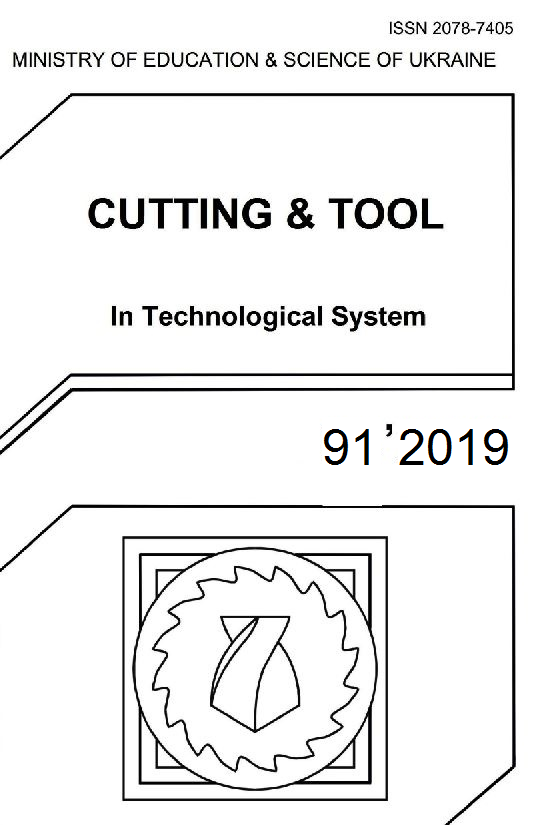EVALUATION OF CHIP MORPHOLOGY WHEN DRILLING TITANIUM ALLOY
DOI:
https://doi.org/10.20998/2078-7405.2019.91.13Keywords:
drilling experiments, tungsten carbide, titanium alloy, types of chips, chip morphology, machining parameters.Abstract
Chip formation within a hole making processes plays an important role in selection of proper machining parameters. Understanding of this phenomenon is also important in relation to wear behaviour or machined surface integrity parameters like roughness, residual stresses and many others. Proposed study aims to compare different shapes and forms of chips produced when drilling titanium alloy Ti-6Al-4V with solid carbide tool by various cutting conditions. The effect of cutting edge radius and side clearance angle on chip formation process was also considered within this work. Experimental data has confirmed strong relationship between drilling parameters and evaluated variable.References
Palanisamy S., McDonald S. D., Dargush M. S. (2009) Effect of coolant pressure on chip formation while turning Ti6Al4V alloy. Int. J. of Mach. Tools and Manufacture (49):73-743.
Brinksmeier E., Pecat O., Rentsch R. (2015) Quantitative analysis of chip extraction in drilling of Ti6A64V. CIRP Annals – Manufacturing Technology (49): 93-96.
Sharif S., Rahim E. A. (2007) Performance of coated and uncoated carbide tools when drilling titanium alloy – Ti6Al4V. Journal of Material Processing Technology (185): 72 – 76.
Li R., Hegde P., SHih A. J. (2007) High-throughput drilling of titanium alloys. Int. J. of Mach. Tools and Manufacture (47): 63 – 74.
Rahim E.A., Kamdani K., Sharif S.: Performance evaluation of uncoated carbide tool in high speed drilling of Ti6Al4V. (2008), J Adv Mech Des Sys Manuf vol. 2, pp. 522–531.
Kim D. - Ramulu, M. - Pedersen, W.: Machinability of titanium/graphite hybrid composites in drilling. In: Transactions of NAMRI/SME. Vol. 33, 2005, pp. 445-452. ISSN 1047-3025.
Mikó B., Palásti – Kovács, B., Sipos S., Drégelyi – Kiss Á. (2015) Investigation of cutting edge preparation process in drilling. Inter. Journal of Machining and Machinability of Materials (6): 529 – 542.
Zhang P.F., Churi N.J., Pei Z.J., Treadwell C.: Mechanical drilling processes for titanium alloys: A literature review. (2008), Machining Science and Technology vol. 12, No. 4, pp. 417-444. ISSN 1532-2483.
Slodki B., Struzikiewicz G., Slusarczyk L. (2016) Influence of cutting fluid conditions and cutting parameters on the chip form in turning of titanium and steel alloys. Key Engineering Materials (686): 74 – 79.
Neslušan M., Czán A. (2001) Obrábanie titánových a niklových zliatin. 195 pp., EDIS Žilina, ISBN 80-7100-933-4.
Dogra M., Sharma V. S., Dureja J. (2011) Effect of tool geometry variation on finish turning – A Review. Journal of Engineering Science and Technology Review (4): 1- 13.
Wyen C. F., Wegener K. (2010) Influence of cutting edge radius on cutting forces in machining titanium. CIRP Annals – Manufacturing Technology (59): 93-96.
Kivak T., Samtas G., Cicek A. (2012) Taguchi method based optimisation of drilling parameters in drilling of AISI 316 steel with PVD monolayer and multilayer coated HSS drills. Measurement (45): ISSN 1547-1557.
Armendia M., Garay A., Iriarte L. M., Arrazola P. J. (2010) Comparison of the machinabilities of Ti6Al4V and TIMETAL 54M using uncoated WC – Co tools. Journal of Materials Processing Technology (210): 197 – 203.
Durakbasa N. M., Bas G. (2013) Surface Roughness Investigation of the Cutting Edge of the High Precision Cutting Tools Enabled by Micro and Nanometrological Measurements. Proceedings of the XXVII. microCAD International Scientific Conference. ISBN 978-963-358-018-9; 5 pages.
Downloads
Published
Issue
Section
License
Copyright Notice
Authors who publish with this Collection agree to the following terms:
1. Authors retain copyright and grant the Collection right of first publication with the work simultaneously licensed under a Creative Commons Attribution License that allows others to share the work with an acknowledgement of the work's authorship and initial publication in this Collection.
2. Authors are able to enter into separate, additional contractual arrangements for the non-exclusive distribution of the Collection's published version of the work (e.g., post it to an institutional repository or publish it in a book), with an acknowledgement of its initial publication in this Collection.
3. Authors are permitted and encouraged to post their work online (e.g., in institutional repositories or on their website) prior to and during the submission process, as it can lead to productive exchanges, as well as earlier and greater citation of published work.

